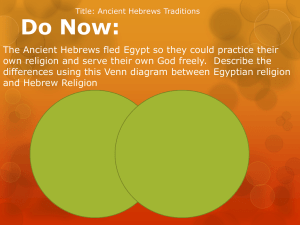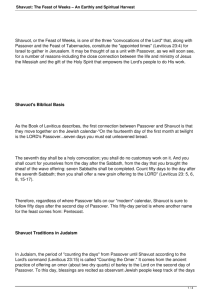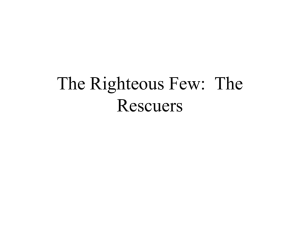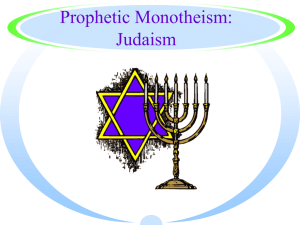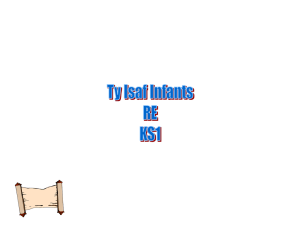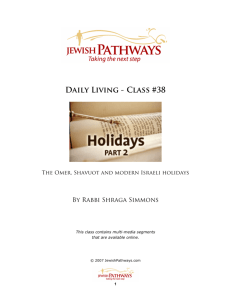Jewish Holiday Food Around the World
advertisement
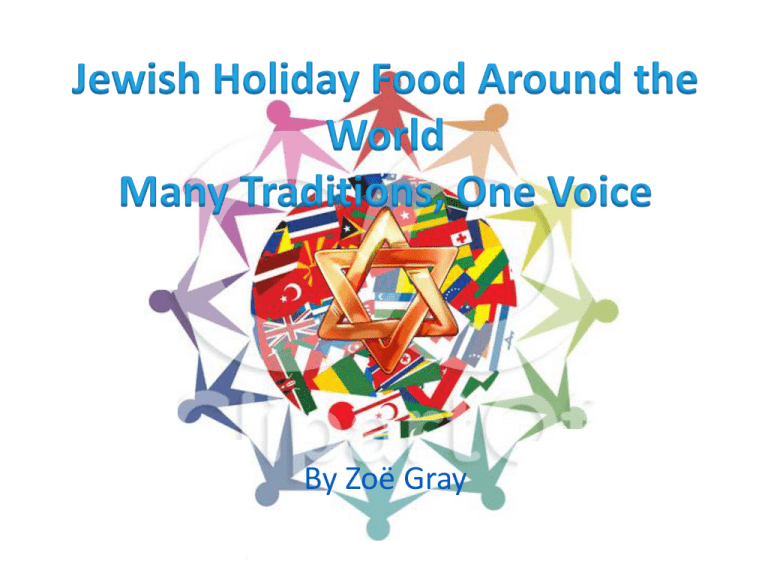
By ByZoë ZoëGray Gray We are the World • The Jewish people are all over the world. There are Chinese Jews, Argentinian Jews, Spanish Jews, Australian Jews, Ethiopian Jews, Indian Jews… You name it! • Jewish traditions combine with the flavor of culture unique to a country to create a rich blend of heritage and faith. • There are many Jewish holidays and therefore much food diversity to discuss. For this presentation, I have chosen Shavuot, Hanukkah, and Passover. Shavuot 101 • Each Shavuot, the Jewish people renew their acceptance of God’s gift of the Torah on Mount Sinai over 3300 years ago. We pledge everlasting loyalty, and God promises eternal devotion in return. • Shavuot means “weeks”. It counts seven weeks from the end of Passover. • In ancient times- bikkurim. Bringing the best of your harvest to God. • Customary to eat dairy foods, because when we received the Torah, the Jewish people couldn’t have meat since the pots had not been kashered (purified in the kosher manner) Traditional Shavuot Food • Dairy foods, because when the Israelites received the Torah, there was no kosher meat available • Creamy pasta dishes- see above about dairy • Dessert!!! (because the Torah is compared to honey) • Cheesecake and blintzes are the most popular. :D • Fruits and veggies, like fancy salad variations, as Shavuot celebrates the harvest Shavuot Food in Persia • Polao mastin- dish made of rice and milk. Think the Spanish dessert arroz con leche. • Kotcha shiri- a special traditional dairy cake Shavuot Food in Greece • Sutlag- special dairy porridge made with cinnamon. Kind of like arroz con leche meets cream of wheat cereal. Shavuot Food in Poland • One. Word. CHEESECAKE! Shavuot Food in Iraq • Sambusak- a savory pastry filled with cheese Shavuot Food in Libya Shavuot Food in Libya • Necklaces strung with cookies or pretzels in symbolic shapes are made by parents for the children Hanukkah 101 • Quick summary- the Seleucids (Syrian-Greeks) oppressed the Israelites, commanding them to renounce their faith • A small band of Jews named the Macabees after their leader Judah Macabee (meaning hammer) defeated the Greek army with God’s help • The Greeks had destroyed the holy temple and unpurified it with a pig sacrifice. The Jews purified the temple and rededicated it. • When they wanted to light the menorah, they only found enough oil for one day. But miraculously , it lasted for eight days. • This is where we get the sentence that the Hebrew letters on the dreidel stand for: A great miracle happened there. • Celebrates light over darkness, purity over adulteration, and spirituality over materiality Traditional Hanukkah Food • Latkes- fried potato pancakes. Served with sour cream or applesauce. (For the health-conscious party pooper, non-traditional lakes can be made from veggies. -_- ) • Gelt- chocolate coins • Sufganiyot- jelly doughnuts traditionally from Israel. Usually coated in confectioner’s sugar. • Lots of fried food commemorating the oil that lit the menorah for eight days and nights instead of one Hanukkah Food in Libya and Morocco • Sfenz- sufganiyot with an exotic twist: filled with orange peel, finely chopped almonds and orange-flower water; dipped in syrup of sugar, vanilla, lemon juice and orange-flower water Hanukkah Food in Greece • Burmuelos- variation of sufganiyot: deep-fried fritters also served with a syrup made of honey, sugar, and water Hanukkah Food in Italy • Zeppoles- variation on sufganiyot: similar to the French beignets of New Orleans, but are chewier, like pizza dough. Sprinkled with the classic powdered sugar. Hanukkah Food in Syria • Atayef- traditionally an Arab dessert, in which the batter is only cooked on one side, then filled with cheese or mixed nuts, raisins, powdered sugar, vanilla extract, and cinnamon. The Hanukkah variation treats it like a latke and deep-fries it, or (rarely) bakes it and serves it with hot syrup or honey. Passover! The Passover Story • Celebrates the liberation of the Jews from slavery under the Egyptian Pharaoh by God. • Pharaoh, afraid of the Jews’ strength and intelligence, orders every baby boy born to the Israelites killed. The parents of Moses tell his sister Miriam to put him in a basket in the river in order to avoid this, and the Pharaoh’s daughter finds him and raises him as the Egyptian prince. • God speaks to him through the form of a burning bush and tells him who he is once he is grown. 10 plagues are sent through Moses from God to the Egyptians when the Pharaoh refuses to free the Israelites. During the last plague, every first-born son dies (including the Pharaoh’s). However, the Israelites had been warned by Moses and smeared lamb blood on their doorposts as he instructed. The Angel of Death, seeing the mark, passed over the Jewish homes and did not kill the sons. The Pharaoh, grief-stricken at his son’s death, frees them. • But he changes their mind as they are about to cross the Red Sea and sends his army after them. Then a miracle happens: Moses raises his staff and God hears his plea and parts the Red Sea. The Israelites cross in safety, but the water closes on the Egyptians, drowning them. Basic Components of Passover • Seder- Family and friends read the Haggadah in a service and at intervals eat ceremonial foods or break for the finding of the Afikomen. • No chametz- leavened bread- allowed for all 8 days of Passover. Matzah only. Traditional Passover Food • Matzah-ball soup • Seder plate: – egg: symbolizes spring and fertility; Christians got the Easter egg from this! – shank bone: symbolizes Paschal sacrifice for the Angel of Death – bitter herbs (maror): remind us of the bitterness of slavery – charoset- chopped apple/nuts/wine; reminds us of mortar and brick when we were slaves – karpas- vegetable, usually parsley; we dip it in saltwater to remind us of the tears we shed • 4 cups of wine! • matzah Passover Food in Argentina • Special Argentinian delicacy – albondigas de papas (meatball and potato dish) • Avocado and lettuce salad • Variant: spinach in matzah balls • Very important to the Argentinians not to have any element of the seder purchased from stores. Even the gefilte fish (sort of like pickled fish cakes- tastes better than it sounds) is made by hand! • • • • • • • Passover Food in India Charoset contains raisins, dates, sesame Passover Food in and India paste Molagachi- mahogany chicken with black pepper Ellegal- spice-rubbed fish in cool herb salsa Malasachi- mutton braised with garlic and coriander Appam- coconut crepes with date sauce Seder plate: includes date jam with walnuts, lime juice, celery instead of parsley Rice, which by Ashkenazi Jews is considered hametz, is allowed Passover Food in Spain • Olive oil used for all Pesach foods • Lots of legumes such as lentils, soybean, rice, corn, chickpeas, green peas, green beans • Charoset includes dates, apricots, oranges, pistachios, pine nuts, and coconuts • Huevos haminado- eggs slow-roasted in onion skins • The American classic brisket is replaced with roast lamb • Pan de Samita- variation on matzah Thanks for traveling with the Jew Crew! We are the World
